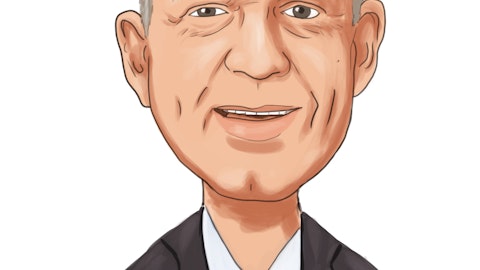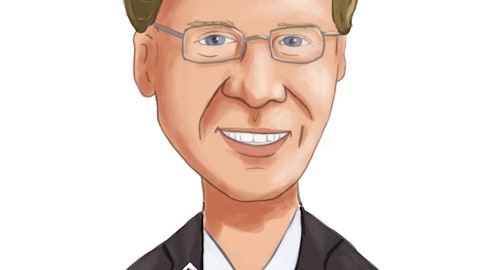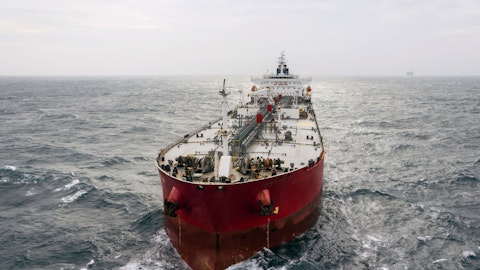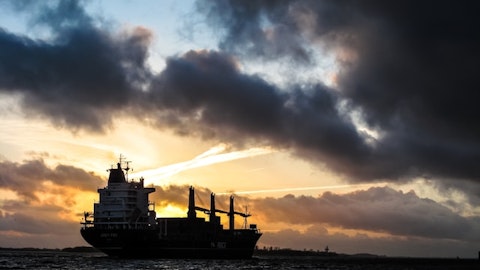Tsakos Energy Navigation Limited (NYSE:TNP) Q4 2022 Earnings Call Transcript March 16, 2023
Operator: Thank you for standing by, ladies and gentlemen and welcome to the Tsakos Energy Navigation Conference Call on the Fourth Quarter 2022 Financial Results. We have with us Mr. Takis Arapoglou, Chairman of the Board; Mr. Nikolas Tsakos, President and CEO; Mr. Paul Durham, Chief Financial Officer; and Mr. George Saroglou, Chief Operating Officer of the company. I must advice you that this conference is being recorded today. And now, I will pass the floor over to Mr. Nicolas Bornozis, Chief President of Capital Link Investor Relations Advisor of Tsakos Energy Navigation. Please go ahead, sir.
Nicolas Bornozis: Thank you very much and good morning to all of our participants. I am Nicolas Bornozis of Capital Link Investor Relations Advisor for Tsakos Energy Navigation. This morning, the company publicly released its financial results for the fourth quarter and year-ended December 31, 2022. In case you do not have a copy of today’s earnings release, please call us at 212-661-7566 or email us at ten@capitallink.com and we will have a copy for you e-mailed right away. Please note that parallel to today’s conference call, there is also a live audio and slide webcast, which can be accessed on the company’s website on the front page at www.tenn.gr. The conference call will follow the presentation slides. So please, we urge you to access the presentation slides on the company’s website.
Please note that the slides of the webcast presentation will be available and archived on the website of the company after the conference call. Also, please note that the slides of the webcast presentation are user controlled and that means that by clicking on the proper button you can move to the next or to the previous slide on your own. At this stage, I would like to read the Safe Harbor statement. This conference call and slide presentation of the webcast contains certain forward-looking statements within the meaning of the Safe Harbor provision of the Private Securities Litigation Reform Act of 1995. Investors are cautioned that such forward-looking statements involve risks and uncertainties, which may affect TEN’s business prospects and results of operations.
And before passing the floor to the Mr. Arapoglou, I would like to €“ we are looking forward to having Dr. Tsakos with us at the Capital Link Forum in New York next Monday. And we would like to congratulate him for being recognized as the person of the year by the Hellenic American Chamber of Commerce next Friday in New York, recognizing and honoring his contribution to Global Shipping to Greece, and also recognizing the fact that TEN is the longest listed Greek company on the New York Stock Exchange, and this recognition coincides with record profitability, a record year for TEN. So, with that, I will pass the floor to Mr. Arapoglou, the Chairman of Tsakos Energy Navigation, please go ahead, Mr. Chairman.
Takis Arapoglou: Thank you, Nicolas. Good morning and good afternoon to everyone, and thank you for attending our call today. Please receive my voice, which is that are managed. and full-year, record results in books since inception. Celebrating with the very positive dividend increase. I need to remind everyone of the TEN model which mitigates negative results in markets and allows the company to strong markets. This model has a lifetime to pay an interrupted dividend since inception. At an average over the U.S. ratio of over 22% of revenues, as I’m sure Nikolas Tsakos would explain later. The main driver of these stellar results about otherwise very unfortunate geopolitical events are the market fundamentals we were more expected to begin for quite some time now.
So, congratulations once again to Nikolas Tsakos and the management team, which apart from operational excellence is the future more, reducing debt, and keeping a to benefit from what seems to be a sustained strong market, despite our . potential has been firmly recognized by the market and the investment in our performance in TEN recent months. But again, well done to all, and we look forward to the continuation of TENs profitable journey going forward. Thank you all, and I’ll hand it over to Nikolas Tsakos. Thank you.
Nikolas Tsakos: Thank you, Chairman, and good morning to everybody or good afternoon, if you are on this side. And we would like to welcome you on our 2022 . As the Chairman said, Nick, thank you very much for reminding us that we are the oldest and the greatest care of the Greek companies on the New York Stock Exchange. But I think that’s a great privilege and great honor and we’re looking to be able to celebrate with you quite soon the event and it coincides with a very good year, record year. But I think whenever we talk, we talk about the record year, people get a bit worried thinking that we have really reached a peak. This is something that we hope or as we can see from the fundamentals and the actual market conditions that we’re facing right now.
But 2023, has started as an ever stronger year than 2022 has done. So, by coincidence, we will be celebrating 30 years as public company started on the Oslo Stock Exchange in 1993. So, we hope as our CEO has said that we can see the share above the $30 within our 30th anniversary. And looking at where we are today, TEN has maintained this model of being able to grow, thrive, and prepare the grounds during difficult markets because the time you want to be investing in assets is when nobody wants to invest and we have been able to achieve this. With following our model and , of course. And then to thrive during the good times, but TEN has never stopped paying a dividend, has never stopped reducing debt, had never had to reconstruct any of its launch.
And of course, this gives a lot of confidence to our clients and that’s why we are a client of choice in good and bad times. This is actually €“ we are going through our fifth €“ for our fifth crisis, which started with the Far East when the 9/11 crisis, the credit crisis of 2008, which I hope we’re not touching again. COVID hit us back in 2020 and then the invasion of Ukraine, but through all these crisis, the company has been able to maintain a dividend and invest at the low points of the cycle and then be able to take advantage of the change of the market, and be able to monetize part of it. That’s what we have been doing. The beginning of 2023 has been a very busy year. I think we have never seen so many sales and purchase transactions in buying and selling ships.
I think we have already done 18 of those transactions in less than three months, of which 8 vessels were sold and 10 vessels were ordered . So, I think quite busy and this prepares the company for an exciting first quarter. It seems that this first quarter is as strong as the first quarter to say the least. Big appetite by clients to renew even vessels, seasoned vessels from good, , like ourselves. And I will ask Paul would you like to give us a little bit of the numbers and then George to give us the ?
Paul Durham: Yes, by all means. Sure. So, the fourth quarter of 2022 resulted in net income of over $100 million, bringing our net income for the year to over $204 million, a new record for the company since 2008. EBITDA increased to almost $160 million in the quarter, adding to our cash reserves for the year-end and reaching staggering amount of over $300 million by the end of the recent year, due mainly to the impact of the events in Eastern Europe through most of 2022. And since the end of the year, our cash reserves have continued to increase taking into account sale of vessels, Revenue in quarter four totaled over $270 million and 94% increase over the prior year. Time charters generated about $460 million in the year, while total revenues in the year amounted to $860 million of which $55 million related to profit share.
Total operating income in the quarter amounted to $122 million, compared to a loss in the prior fourth quarter. In 2022, operating income reached $256 million, compared with a loss of $120 million in the prior year. With 66 vessels operating, our average daily time charter equivalent in the quarter was almost $40,000 in a market that effectively operated with full employment for our vessels at 97%. Only two of our vessels were in dry dock in the quarter, but in the year, 16 vessels undertook dry dock, while certain expenses had increased due in part to the new vessels that incur higher operating expenses and to various other price increases. However, our time charter revenue alone was able to cover all our expenses and still leave significant amounts of free funds.
All our new vessels and orders are financed except to the latest orders and all new buildings are expected to generate strong rewards over the forthcoming years. In the meantime, the company will continue as always to ensure perfect debt service. Given our cash availability, use of funds will be high on management’s financial priorities, and in this respect, we are already preparing plans accordingly regarding the company’s future. And that’s my basic comment. Please note that we shall be filing our 20-F shortly in which there will of course be substantial information included.
Photo by Zachary Theodore on Unsplash
George Saroglou: Thank you, Paul. Good morning to all of you joining our earnings call today. Last year, we had experienced the largest change in trade flows to ongoing crude and oil product movements due to a political action they were in Ukraine and the sanctions that followed on Russian seaborne barrels. These changes could be permanent as Europe, the biggest client of Russian oil managed to replace these barrels with barrels coming from the U.S., West Africa, Vienna, and the Middle East, creating a positive ton mile multiplier effect for tanker demand and rates. At the same time, tanker newbuildings are at an all-time low, 30-year low. And global oil demand is coming back after the COVID pandemic. In fact, despite the ongoing energy transition to renewables, the world understands that its reliance on oil and LNG will last longer, possibly at least until 2050.
Demand is expected to grow by 2 million barrels per day in 2023 based as the latest forecast International Energy Agency. It will be an all-time record at 102 million barrels per day. All lines are, of course, on China, which changed its zero COVID policy in the last quarter of 2022 as of the growth is expected to come from them. Especially, despite global headwinds, inflation, tightening global financial conditions, the war in Ukraine and that continues and geopolitical tensions, the global economy continues to grow. Oil demand, as we said, is growing and tanker fundamentals appear to be favoring a sustainably good tanker market. Let’s go to the slides of our presentation. Starting with Slide 3, we see that since TEN’s inception in 1993, we have faced five major crisis and it’s time the company came out stronger, thanks to its operating model.
This time is no exception. We managed the COVID pandemic without any serious effects for both fleet and offshore operations and we are currently navigating the challenges created by the war in Ukraine and the inflationary pressures on costs. The market fundamentals record low water book and an aging fleet even without this tragic war were positive for the tanker industry. The sanctions imposed on as a result of the war served as an additional catalyst to propel freight rates higher as long established trade routes were disrupted and . Slide 4, we see the company split growth and capital market access since inception. We raised capital for growth countercyclically, not at the top of the market, but at times when the asset prices were usually low.
TEN was set-up in the aftermath the open for double-hull tankers. We started with four modern vessels in 1993 and in three years grew to 12 after raising 130 million from the founders of the company and new energy investors at the Oslo Stock Exchange. Where we listed the company in the New York Stock Exchange in 2002, the company was already transitioning towards a full double-hull company with a series of tailored newbuilding tankers catering to the requirements of our clients. In the blue boxes, you see the company’s common share offerings; and in red, the offerings of preferred shares since the company’s New York Stock Exchange listing. The first two series of 50 million each the Series B and Series C preferreds have already been redeemed at par.
In the next slide, we see the fleet and its current fleet employment. We have an operational fleet of 58 vessels 43 out of the 58 or 74% of the fleet in the water as market exposure, a combination of spot, and time charters with profit sharing. 43 out of 58 or 74% again is in secured projects 6 time charters and time charters with profit sharing. This means that TEN is well-positioned to capture the prevailing positive tanker market fundamentals. Our fourth quarter and calendar 2022 revenue and net income announced today is a testament of TEN’s taking advantage of the good tanker market. We should note here that Maria Energy 2016-built LNG is fixed to a minimum 12 year time charter to a leading Asian natural gas operator at a rate reflecting of current market conditions in the LNG sector.
The vessel is expected to be delivered with a new charter upon completion of the existing time charter in 2026. Greek modality is a key element of our operating model. During 2022, we sold a 2003 built Panamax tanker and a 2006 built LR2 Aframax tanker and took delivery of three modern vessels. Two new buildings in January of 2022, the LNG carrier TEN Energy. In July, the shuttle tanker quarter, and in November DS1, a 2020-built eco-friendly scrubber fitted VLCC. All three vessels are chartered against long accretive time charters. In addition, we announced today the sale of eight Tankers, six 2005-built MRs and two 2006-built handysize tankers, and the buyback with company cash of 2005-built Suezmaxes for a price that today is well under the fair market value.
While these two Suezmaxes currently operate in the spot market, management is exploring the investment opportunities as asset prices continue to trend higher. Any divestment of earlier generation vessels will be replaced with modern eco-friendly greener vessels. On the new building front, we announced today the signing of two scrubber fitted environmentally designed Suezmaxes for delivery at the end of 2025 from a South Korean yard. TEN has currently a new building program consisting of two plus one option shuttle tanker for delivery during 2025, four dual fuel Aframax tanker for delivery in the second half of this year and the first quarter of next, plus two eco-friendly scrubber fitted Suezmaxes that we announced today. Except for these two Suezmaxes, at least for now, that have no , but there is interest.
The rest of the company’s new buildings have been fixed forward against medium to long-term time charters. In Slide 6, we present the company’s current and long-term clients. As you see, we have a blue chip customer base consisting of four major global energy companies, refineries, commodity traders with Equinor guidance with topping the list as our largest charter with nine vessels and four newbuilding all on long-time charters. In Slide 7, the left side presents the all-in breakeven cost for the various vessel types we operate in TEN. We maintain a low cost base. We have a simple operating model. We try to have our tank charter vessel generate revenue to cover the company’s cost expenses paying for the vessel operating expenses, finance expenses, overheads, cost and commissions and net revenue from the spot trading vessels opportunistically contribute to the profitability of the company.
Despite the prevailing inflationary pressures, we want to highlight the purchasing power of our technical manager and the continuous cost control efforts by management to maintain a low OpEx average for the fleet, while keeping a high fleet utilization rate quarter-after-quarter, year-after-year. Despite 16 special surveys, of schedule in preparation, for the anticipated market upturn, we achieved an overall utilization of almost 95% for the fleet. And thanks to the profit sharing element for every $1,000 increase in the spot rates, we have a positive $0.19 impact in annual EPS based on the number of TEN vessels that currently have exposure to spot rates. Debt reduction is an integral part of the company’s capital allocation strategy. The company’s debt picked in December of 2016.
Since then, we have repaid 360 million of debt and repurchased 100 million step-up preferred shares that we had outstanding. In addition to paying down debt, dividend continuity is important for our common shareholders and management. TEN has always paid the dividend irrespective of the market cyclicality. The company announced today an annual dividend of $0.60 for 2023. $0.30 will be paid in June and the other $0.30 will be paid in December. This compares with per common share paid last year, a 140% increase. Following the dividend announced today, the company will have paid in excess of 516 million in dividends since the initial listing in 2002. Global oil demand continues to recover as the world emerges from the COVID pandemic. China recently changed a strict zero COVID policy.
This policy change should have a very positive impact on Chinese and global oil demand in 2023. Despite financial and geopolitical headwinds, the International Energy Agency expects global oil demand to grow by approximately 2 million barrels in 2023. Most of the growth is coming from the Asia Pacific region, fueled by a in China. On the supply side, most of the growth in 2023 is expected from non-OPEC plus countries like Brazil, the U.S., Vienna, Canada, Mexico, and Norway. As global oil demand continues to grow, let’s look at the for supply of tankers in Slide 11. The order book stands at a little over 4% over the next three years, the lowest it has been in more than 30. At the same time, a big part of the fleet is over and almost 10% of the fleet is currently over 20 years.
Although scrapping activity has come down, which is natural, last year, we have upcoming regulations in the industry with the carbonization initiatives and almost 10% of the fleet being over . We think that all these factors point to a balanced tanker supply market for the years ahead. And with that, I will return the call back to Nicolas for the Q&A. Thank you.
Nikolas Tsakos: Thank you, George, for giving us a full picture of quite an exciting year. And a lot of excitement, as I say, has begun with 2023 where market fundamentals are remaining strong. There is some weakness in the price of oil. It is, I think, a welcomed and positive for the tanker industry. And I’ve been saying this for, as long as Mr. Bornozis said, we’ve been on the New York Stock Exchange and Stock Exchanges, that there is always a correlation €“ reverse correlation with tanker rates and the price of oil. So, I think what we are seeing in the recent weeks, the normalization of the price €“ in the price of oil. We are in a low inventory environment. The world has suffered from high oil prices in the last, at least four quarters.
So, we see that the correction and the price of oil becoming to more affordable levels for the world is good to drive more business for ourselves. And we see this in the demand from for long-term businesses that I don’t think we have seen again. As you know, we do monitor all of our business on profit sharing arrangements, but today, VLCC could easily go for a year close to $70,000, as Suezmax about and very similar the Aframax rates. And these are also for a couple of years. So, there is a positive environment for where we’re going forward. And that’s why we took the opportunity to order vessels of new generation that will be able to fulfill the requirement of the major oil companies. I think right now, we are having a balanced profit sharing and spot environment.
Our LNG is €“ one of our LNG is opening in the next couple of months and this is going to significant, I think she will have at least another by itself and close to $1 a year of net income by a new charter. So, that’s a very positive situation going forward. And we will be welcoming our new vessels as of October of 2023. The first of our dual fuel vessels. We took the opportunity to sell our older product tankers at prices that we did not expect to ever see again, not far the original purchase values some time ago. So, we are renewing that part of the business going forward. Looking back and in view of our presentation next week, we have seen that TEN through the years has €“ this year has made the net income over the last 20 years on the stock exchange of $2.3 billion in a very cyclical market and has paid dividends of€“ in excess of as our CEO said and we are looking at this trend.
We hope that this trend to continue at least for the foreseeable future for us. And of course, the other energy companies out there. And with this, I would like to thank all of you for your support. Over the last 20 years it has been an enjoyable ride. And looking forward for a few more years of excitement, and we’d like to open the floor for any questions.
See also 12 Biggest Health Insurance Companies in the World and 10 Stocks ChatGPT Says Will Make Me Rich in 10 Years.
Q&A Session
Follow Tsakos Energy Navigation Ltd (NYSE:TNP)
Follow Tsakos Energy Navigation Ltd (NYSE:TNP)
Operator: Thank you. Thank you. Our first question is from Climent Molins with Value Investors. Please proceed with your question.
Climent Molins: Good morning. Thank you for taking my questions. I wanted to start by asking about the dividend you announced today. How should we think about it? Because on the capital event in January, you mentioned that DMP really intensely tribute between 25% and 50% of net income during , is that still the board’s intention?
Nikolas Tsakos: Yes. I mean, this has always been €“ thanks for €“ good morning to you and thanks for your question. If you look at the historical figures I announced out of 2.3 billion of net income, we have already distributed 5 €“ in total, . So, that’s about 20 €“ close to between 25% and 30%. And yes, we will maintain the same policy. And always build-up cash. I believe that if things continue, we would be close to $0.5 billion of liquidity within this year, which I think will give us a lot of security going forward and a lot of ammunition to invest in new and more environmentally friendly vessels.
Climent Molins: Thanks for the color. During the quarter, you issued 570,000 shares for 10.4 million, could you provide some insight on the reasoning behind that decision? And looking ahead, should we expect additional ATM usage?
Nikolas Tsakos: That was a program that we had to complete within the year. That was a decision taken in the early parts of 2022. And it was completed €“ with the liquidity that the company is building up on a daily basis, I don’t foresee any similar transactions now that this program has been completed.
Climent Molins: That’s helpful. Thank you. And final question from me. You mentioned the new contract on the new energy will add at least another dollar in net income by itself. Could you provide some additional commentary on the terms of the new contract? For example, the TCE or the contract duration?
Nikolas Tsakos: We are looking at yearly contracts in excess of $100,000 a day, but that’s about or if we decide to do a two-year contract about $85,000 a day, so, yes, that’s how we can do the figure I mentioned to you.
Climent Molins: Makes sense. So, it’s not peak yet ,right?
Nikolas Tsakos: Exactly.
Climent Molins: All right. Thank you for taking my questions and congratulations for the quarter.
Nikolas Tsakos: Thank you very much.
Operator: Thank you. There are no further questions at this time. I’d like to hand the floor back over to Dr. Nikolas Tsakos for any closing comments.
Nikolas Tsakos: Well, first of all, thank you for supporting the company over this year. We are actually looking at this, and I know whenever someone talks about very strong quarter, you have people thinking that the market has picked. The solid fundamentals that I think our COO presented and I think you are all familiar with the market shows that we are in the tankers in a situation because of the lack of knowledge, of what actual engines, our vessels should be designed or built with the lowest replacement program or newbuilding program since I’ve been in business in 30 years. I think the whole industry €“ the whole tanker industry is close to 4%. And I think segments €“ the big segments closer to 2.8% to 3%. This is unprecedented.

